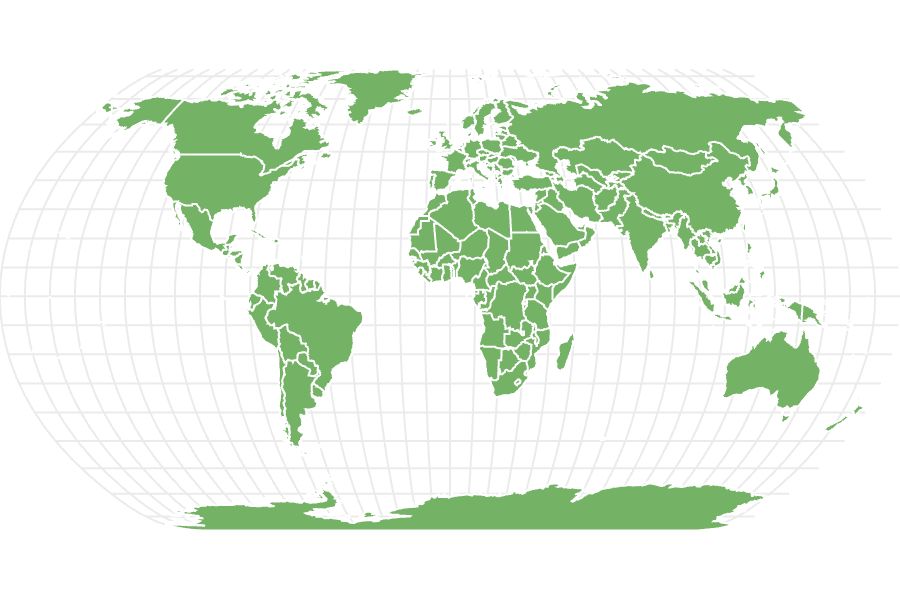Herring
People enjoy the taste of the oily fish in many different ways including pickled, smoked, salted, dried and fermented.
Advertisement
Herring Scientific Classification
Read our Complete Guide to Classification of Animals.
Herring Conservation Status
Herring Facts
- Prey
- Zooplankton, phytoplankton
- Group Behavior
- School
- Fun Fact
- People enjoy the taste of the oily fish in many different ways including pickled, smoked, salted, dried and fermented.
- Estimated Population Size
- Variable and depending on species
- Biggest Threat
- Overfishing
- Most Distinctive Feature
- Huge schools
- Other Name(s)
- Silver darlings, silver of the sea
- Gestation Period
- 11-40 days depending on water temperature
- Habitat
- Temperate waters
- Predators
- Seabirds, marine mammals, predatory fish, fishermen
- Diet
- Carnivore
- Type
- Vertebrate, Clupeoid
- Common Name
- Herring
- Number Of Species
- 200
View all of the Herring images!
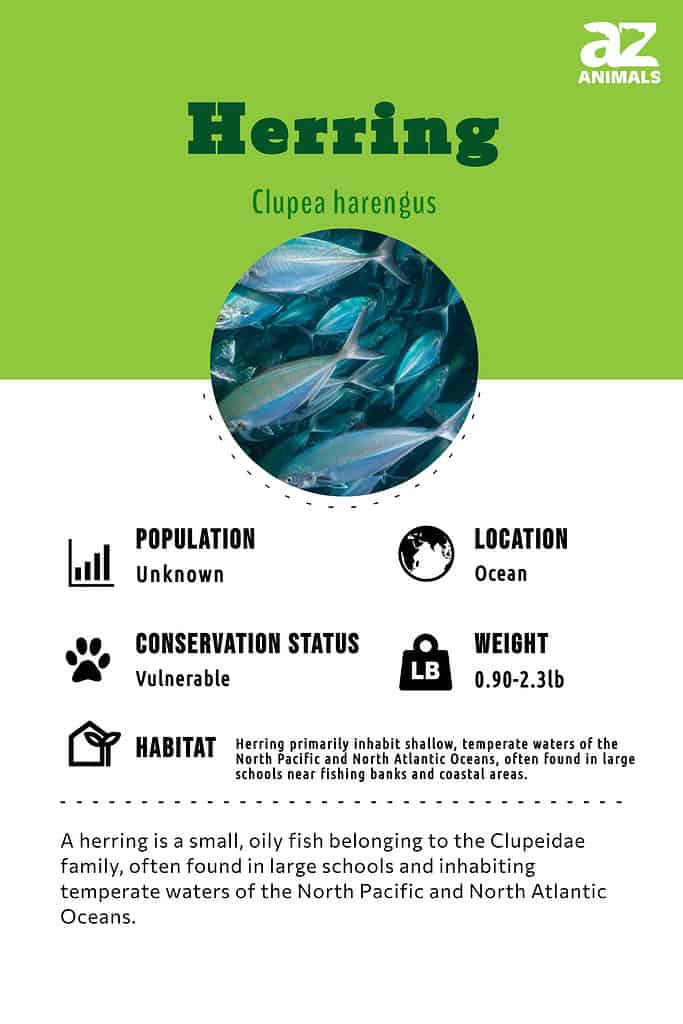
Herring are forage fishes, also known as silver darlings or silver of the sea.
Herring fish are pelagic, meaning they live in the open sea beyond the low tide mark. Most live in the temperate, shallow waters of the North Pacific and North Atlantic Oceans. They are a major food source as baitfish and for human consumption in recipes with different tastes such as fermented, pickled, smoked, and dried. Some species are vulnerable due to overfishing.
5 Incredible Herring Facts
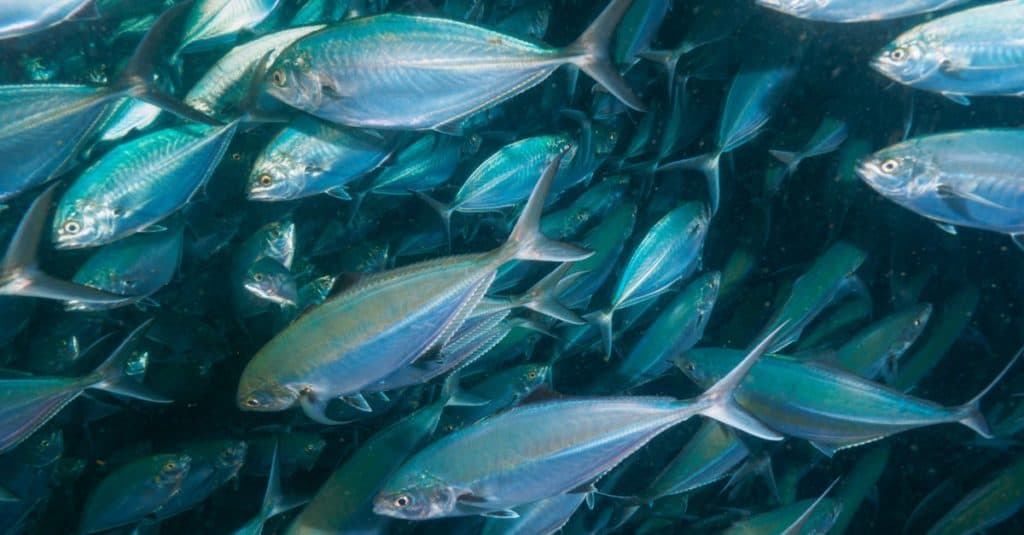
The Araucanian, Atlantic, and Pacific species collectively constitute 90% of the herrings that are harvested in fisheries.
©Mayumi.K.Photography/Shutterstock.com
- The Araucanian, Atlantic, and Pacific species make up 90% of the herrings caught in fisheries.
- The Atlantic herring makes up over half of all herring captured.
- A school in the North Atlantic Ocean can reach up to 3 billion fish, with the fish occupying up to 4.8 cubic kilometers with fish densities between 0.5 and 1.0 fish/cubic meter.
- Herring fish can move up to 10 times their body length per second.
- Herring fish have excellent hearing.
Classification and Scientific Name
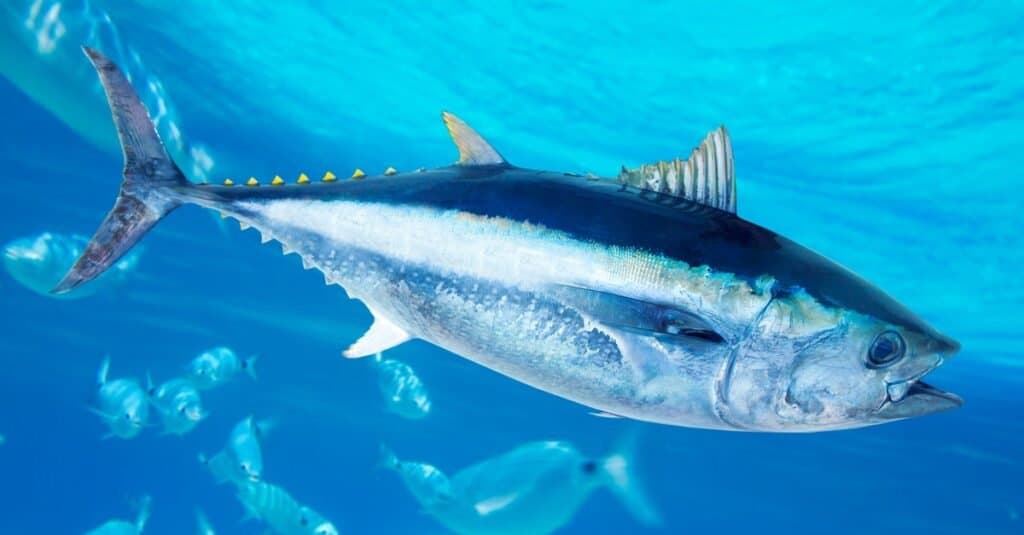
Bluefin tuna
(Thunnus thynnus), saltwater fish in the Mediterranean. This type of rare fish is a fierce predator that feeds on herring, mackerel, and other ocean fish.
©lunamarina/Shutterstock.com
The definition of this fish is a small forage fish that usually belongs to the family Clupeidae. Clupea is the type genus of the family Clupeidae, although there are other genera. For example, the wolf herrings are in the genus Chirocentrus and the family Chirocentridae, although “wolf herring” can refer to either of the two subspecies. The three species of the Clupea genus are the Atlantic, the Pacific, and the Araucanian herring.
Evolution and Origins
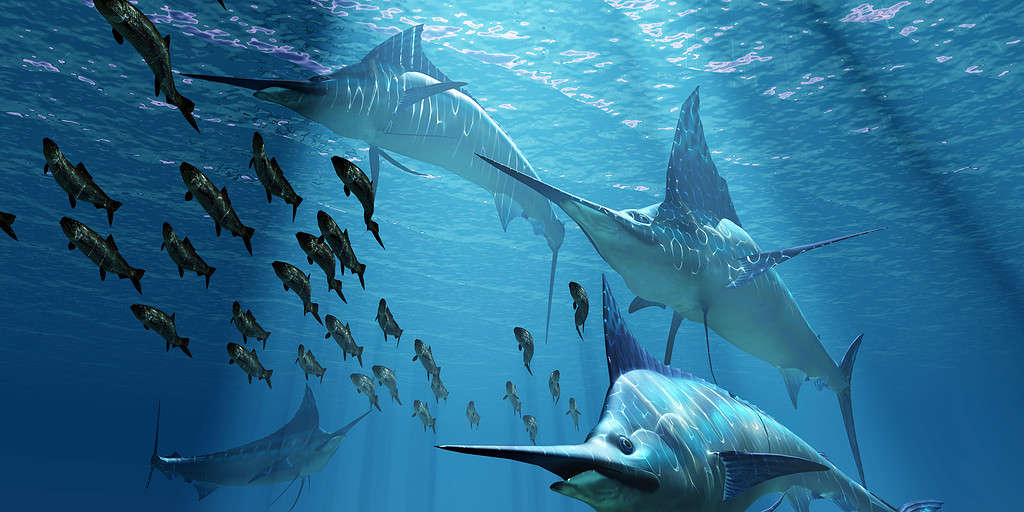
A pack of Indo-Pacific Blue Marlin predatory fish hunts a school of Pacific Herring fish.
©iStock.com/CoreyFord
The surname Herring has early origins in the Old French term hareng, while later instances can be traced back to the Old English word hering. The Old English terms hæring and hering, from which it was derived, also signify herring.
Herring, a type of forage fish, primarily belong to the Clupeidae family. They commonly travel in expansive groups near fishing banks and coastal areas, mainly inhabiting shallow, temperate waters in the North Pacific and North Atlantic Oceans. They can also be found in the Baltic Sea and off the western coast of South America.
According to scientists, herring have been an essential part of the food and culture in the Salish Sea for over 12,500 years since human settlement in the area. Despite a decline in herring populations in certain parts of the region, their significance has persisted throughout history and into the present day.
Species
There are 200 species in the family Clupeidae. Some notable species are:
- Araucanian (Clupea bentincki)
- Pacific (Clupea pallasii)
- Atlantic (Clupea harengus)
- Baltic (Clupea harengus membras)
- Wolf: 2 subspecies, the Dorab wolf-herring (Chirocentrus dorab) and the Whitefin wolf-herring (Chirocentrus nudus)
- River herring: 2 subspecies, the Blueback herring (Alosa aestivalis) and Alewife (Alosa pseudoharengus)
Appearance
Herring fish are bright silver with a bluish or greenish back. All species in the family Clupeidae share a soft, single, and spineless dorsal fin, small head, protruding lower jaw, and no lateral line, while those in the family Chirocentridae are ray-finned. Their length and weight vary depending on the species.
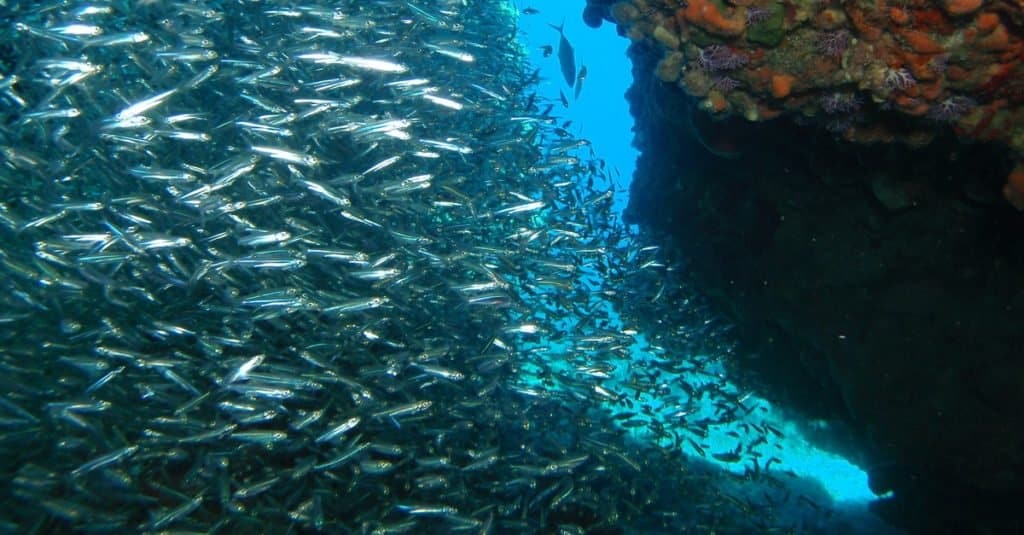
Herring fish are bright silver with a bluish or greenish back.
©iStock.com/Hoatzinexp
Distribution, Population, and Habitat
Atlantic species live on both sides of the Atlantic Ocean, while Pacific species live in the North Pacific Ocean and Arauceanian species live off the coast of Chile. Many species are marine, while others are anadromous, such as the blueback and alewife subspecies of river herrings. On the other hand, the toothed river herring or Papuan river sprat (Clupeoides papuensis) is a freshwater species.
Predators and Prey
The definition of these fish in terms of diet is a small forage fish or filter-feeding fish. They consume many animals that are smaller than them, including various types of zooplankton and phytoplankton. They make up for their small size by forming huge schools and with their excellent hearing, they can quickly react to predators.
What do herring eat?
These fish eat copepods, arrow worms, krill, mysids, pteropods, annelids, and pelagic amphipods. They also eat other tiny crustaceans and worms, smaller fish, diatoms, tintinnids, fish larvae, larval snails, molluscan larvae, and menhaden larvae.
What eats herring?
The Western grebes, common murres, Atlantic puffins, razorbills, common terns, and Arctic terns are some examples of seabirds that depend on these fish. Marine mammals that eat them are dolphins, porpoises, whales, seals, and sea-lions, while the predatory fish that eat these fish are sharks (including thresher sharks and spinner sharks), swordfish, sailfish and other billfish, tuna, salmon, striped bass, cod, and halibut. Fishermen catch mostly Clupea species.
Reproduction and Lifespan
These fish reproduce through spawning. They spawn once a year after reaching sexual maturity at 3 or 4 years of age, although at least one Atlantic species spawns every month of the year. Some species are anadromous, meaning they live in salt water but migrate to fresh water for spawnings, such as the blueback and the alewife.
The season and location in which the fish spawns depend on the species. For example, those in Greenland spawn in 0-5m (0-16ft) of water, while those in the North Sea spawn at down to 200m (660ft) in the fall. Females lay the eggs on the sea bed, on rock, stones, gravel, sand, or in algae beds, with the highest survival being in crevices and behind solid structures in order to avoid open exposure to predators. They may lay anywhere from 20,000-40,000 eggs depending on their age and size but on average about 30,000.
The eggs sink, settle and stick together as well as to any sediment or debris due to their mucous coating. They need continuous microturbulence from wave action or coastal currents to ensure the layers are not too thick with mucus, which would deplete their oxygen and kill them. Their incubation time is 40 days at 3 °C (37 °F), 15 days at 7 °C (45 °F), or 11 days at 10 °C (50 °F). They die at temperatures above 19 °C (66 °F). Individual eggs are 1-1.4mm (3/64-1/16in) in diameter.
Fishing and Cooking
The Pacific thread herring, red-eye round herring, and whitehead’s round herring make up the remaining 10% of these fish caught in fisheries, and they are not of the Clupea genus. However, all species are important, even the smallest ones. One of its main uses is baitfish.
There are also useful by-products of fish oil, which is used as a nutritional supplement, and fishmeal, which is used as farm animal feed.
However, their most important use is as a food source, with a taste at its most basic described as mild, oily, and flaky. The most common recipes involve them being eaten raw, salted, fermented, dried, pickled, or smoked, with the eggs being valued as a caviar substitute. They are most commonly eaten in Baltic countries and the British Isles.
Fermented herring
The most popular example of fermented herring is the Swedish surströmming, which has been traditional since the 16th century. It uses Baltic fish, which is lightly salted and fermented for 6 months before being canned. A newly opened can is said to have one of the most putrid smells in the world.
Dried herring
Dried herring are a common breakfast staple in the Phillippines along with garlic rice and eggs. The fish is typically dried with salt and is also called salted dried herring.
Pickled herring
German, Nordic, Dutch, Polish, Baltic, and Jewish cuisines all include pickled herrings. The two-step process involves curing with salt and then removing the salt and adding other spices or flavorings.
Kippered or red herring
Kippered or red herring is called kippers. They turn red due to being smoked, a curing process that is done on the fish during the spawning season when they don’t taste as good. Canned kippered fish is called “kipper snacks” and is typically eaten in the British Isles and Scandinavia.
Population
These fish populations fluctuate with fishing and reproduction, which replaces the older fish with young ones. The species with a Vulnerable conservation status according to the IUCN are: Blueback (Alosa aestivalis), Venezuelan (Jenkinsia parvula), Galapagos thread herring (Opisthonema berlangai), Denticle (Denticeps clupeoides), Cuban longfin herring (Neoopisthopterus cubanus) and Vaqueira longfin herring (Opisthopterus effulgens). Their common threat is overfishing.
View all 104 animals that start with HHerring FAQs (Frequently Asked Questions)
What is herring?
The definition of a herring is usually a small forage fish from the family Clupeidae, with most being from the genus Clupea.
Where are herring found?
Herring lives in the Atlantic and Pacific Oceans, the Baltic Sea, and off the west coast of South America.
What is a red herring?
A red herring also called a kippered herring or a kipper, is a smoked herring, so-called due to its color.
Is herring a good fish to eat?
Herring is an oily fish that is high in Omega-3 fatty acids, vitamin D, selenium, and every other essential nutrient in varying proportions.
Is a herring the same as a sardine?
No. Although herrings are often marketed as sardines or pilchards because they are so similar, herrings and sardines are different fish species that belong to the family Clupeidae. It is also believed that sardines are just smaller herrings.
How big do herrings get?
The size of a herring depends on its age and species. They can be as small as 10.5cm (4.1in) or as large as 60cm (23.6in).
What Kingdom do Herring belong to?
Herring belong to the Kingdom Animalia.
How do Herrings have babies?
Herrings lay eggs.
What are the key differences between herring and sardines?
The greatest differences between herring and sardines can be found in their potential size and phylogenetic families. Fish considered sardines are often heavier than herring, weighing between 0.2 and 4.5 pounds compared to the herring, which tops out at 2.2 pounds.
Thank you for reading! Have some feedback for us? Contact the AZ Animals editorial team.
Sources
- Wikipedia / Accessed December 31, 2020
- MiMi / Accessed December 31, 2020
- National Geographic / Accessed December 31, 2020
- eHow UK / Accessed December 31, 2020
- World Wildlife Fund / Accessed December 31, 2020
- Nutrition Advance / Accessed December 31, 2020

